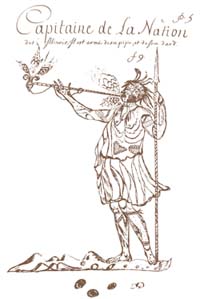
Jacques Marquette and Louis Jolliet met the "great Captain," or chief, of the Peoria tribe at his village near the Des Moines River in 1673. At that time, each of the Illinois tribes evidently lived in its own village or its own part of a multi-tribal village. Political leadership was provided by peace chiefs, who were highly respected by tribal members and who were responsible for directing communal hunting expeditions and for interacting with the leaders or representatives of other ethnic groups. The role of chief was generally reserved for men, although women of influence sometimes became village chiefs. Peace chiefs had relatively little power and authority; they presided over the tribe using persuasion rather than force.
The Illinois also had war chiefs, men who planned and directed raids on other tribes. Any aspiring warrior could become a war chief, but only if he could convince his fellow warriors that his personal animal spirit (war manitou) would protect the war party and ensure victory. The authority of a war chief was strictly limited to the duration of his expedition, and he was allowed to lead new expeditions only if his previous raids were successful. The war chief hosted a special feast for his warriors prior to their departure and maintained the group's war bundle during the expedition. If the war party suffered any casualties, the war chief was required to compensate the victim's relatives with gifts and seek revenge by leading another raid.![]()
|
|
Copyright © 2000 Illinois State Museum
